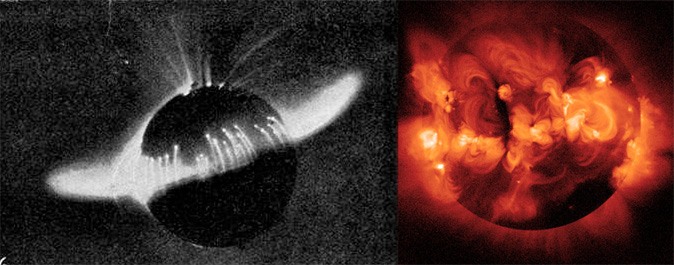Which still tells us nothing about whether your iron shell idea can maintain a temperature far below the 6000 K layer of the sun that we see. I've asked you to quantify your ideas. You repeatedly refuse, even though such a task is easy. Very well, I shall endeavor to do so for you.
Let's say we've got mass being ejected from your solid surface. This mass is supposedly taking heat away with it - it therefore must be mostly on a one-way journey, or else it would take heat
back with it from somewhere hotter, and so the solid shell would heat up. So how much mass can we lose on a continual basis? Well, let's ballpark this as being about the same amount of mass we get in the solar wind (that way we don't make the atmosphere above our solid shell any thicker or thinner). That's about
6.7 billion tons per hour, or about 1.7x10
9 kg/s. Now the visible layer of the sun is radiating about 3.8x10
28 Watts outwards, but that layer will radiate inwards as well. In order to keep from heating up, we need to carry away the heat from this. But let's be generous. Let's suppose (with no evidence) that your solid surface is incredibly reflective, so that only 1% of the light is absorbed. Now we only need to carry away 3.8x10
26 Joules/sec. This means that each kg of mass that's being ejected must carry with it 2.2x10
17 Joules. In other words, each kg must absorb more than twice its own rest mass in energy. Which, let's be frank, is an absolute absurdity.
OK, so let's see if we can fudge these numbers a bit. Let's suppose that we instead start with a more reasonable heat absorption, and then try to figure out the mass. The energy to ionize a hydrogen atom is 13.6 eV, which corresponds to 1.3x10
9 J/kg. Each proton and electron will act like an ideal gas molecule in the plasma state, so if we heat up from 0 to 6000 K (we can't heat up any more than that), we get 1.5
7 J/kg. So the total is still about 1.3x10
9 J/kg. Of course, I'm being incredibly generous here, since not all the gas would be ionized, and that's clearly the dominant contribution to the heat capacity at these temperatures. So again assuming only 1% absorption, how much mass do we need? 2.9x10
17 kg/s. That's eight orders of magnitude larger than the solar wind. How long could the interior of the sun last losing this much mass? Well, the sun is about 2x10
30 kg, so that's about 6.9x10
12 seconds, or roughly 220,000 years. Again, absurd. Clearly that's far too large a mass flow to be sustainable.
The numbers don't work out, Michael. Not by MANY orders of magnitude. This took me maybe 10 minutes. Back of the envelope calculations. Easy to do, no fancy calculus, just simple multiplication, unit conversions, and easy-to-find input numbers. But you didn't do anything like this. You didn't test the fundamental parameters of your own theory to test whether it made even the slightest amount of sense. If you did, you would have realized how absurd it was. Now that you've had the calculations presented to you, what will you make of them? Will you realize your mistake? Or will you bury your head in the sand?


